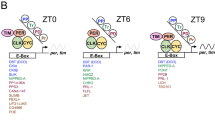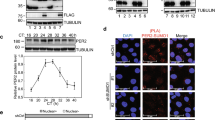Abstract
Protein phosphorylation has a key role in modulating the stabilities of circadian clock proteins in a manner specific to the time of day1. A conserved feature of animal clocks is that Period (Per) proteins undergo daily rhythms in phosphorylation and levels2,3, events that are crucial for normal clock progression4,5,6,7. Casein kinase Iε (CKIε) has a prominent role in regulating the phosphorylation and abundance of Per proteins in animals8. This was first shown in Drosophila with the characterization of Doubletime (Dbt), a homologue of vertebrate casein kinase Iε4,6. However, it is not clear how Dbt regulates the levels of Per. Here we show, using a cell culture system, that Dbt promotes the progressive phosphorylation of Per, leading to the rapid degradation of hyperphosphorylated isoforms by the ubiquitin–proteasome pathway. Slimb, an F-box/WD40-repeat protein functioning in the ubiquitin–proteasome pathway9,10 interacts preferentially with phosphorylated Per and stimulates its degradation. Overexpression of slimb or expression in clock cells of a dominant-negative version of slimb disrupts normal rhythmic activity in flies. Our findings suggest that hyperphosphorylated Per is targeted to the proteasome by interactions with Slimb.
This is a preview of subscription content, access via your institution
Access options
Subscribe to this journal
Receive 51 print issues and online access
$199.00 per year
only $3.90 per issue
Buy this article
- Purchase on Springer Link
- Instant access to full article PDF
Prices may be subject to local taxes which are calculated during checkout






Similar content being viewed by others
References
Edery, I. Role of posttranscriptional regulation in circadian clocks: lessons from Drosophila. Chronobiol. Int. 16, 377–414 (1999)
Edery, I., Zwiebel, L. J., Dembinska, M. E. & Rosbash, M. Temporal phosphorylation of the Drosophila period protein. Proc. Natl Acad. Sci. USA 91, 2260–2264 (1994)
Lee, C., Etchegaray, J. P., Cagampang, F. R., Loudon, A. S. & Reppert, S. M. Posttranslational mechanisms regulate the mammalian circadian clock. Cell 107, 855–867 (2001)
Kloss, B. et al. The Drosophila clock gene double-time encodes a protein closely related to human casein kinase Iɛ. Cell 94, 97–107 (1998)
Lowrey, P. L. et al. Positional syntenic cloning and functional characterization of the mammalian circadian mutation tau. Science 288, 483–492 (2000)
Price, J. L. et al. double-time is a novel Drosophila clock gene that regulates PERIOD protein accumulation. Cell 94, 83–95 (1998)
Toh, K. L. et al. An hPer2 phosphorylation site mutation in familial advanced sleep phase syndrome. Science 291, 1040–1043 (2001)
Eide, E. J. & Virshup, D. M. Casein kinase I: another cog in the circadian clockworks. Chronobiol. Int. 18, 389–398 (2001)
Kipreos, E. T. & Pagano, M. The F-box protein family. Genome Biol. 1, 30021–30027 (2000)
Jiang, J. & Struhl, G. Regulation of the Hedgehog and Wingless signalling pathways by the F-box/WD40-repeat protein Slimb. Nature 391, 493–496 (1998)
Kloss, B., Rothenfluh, A., Young, M. W. & Saez, L. Phosphorylation of PERIOD is influenced by cycling physical associations of DOUBLE-TIME, PERIOD, and TIMELESS in the Drosophila clock. Neuron 30, 699–706 (2001)
Rothenfluh, A., Abodeely, M. & Young, M. W. Short-period mutations of per affect a double-time-dependent step in the Drosophila circadian clock. Curr. Biol. 10, 1399–1402 (2000)
Akashi, M., Tsuchiya, Y., Yoshino, T. & Nishida, E. Control of intracellular dynamics of mammalian period proteins by casein kinase Iɛ (CKIɛ) and CKIδ in cultured cells. Mol. Cell. Biol. 22, 1693–1703 (2002)
Yagita, K. et al. Nucleocytoplasmic shuttling and mCRY-dependent inhibition of ubiquitylation of the mPER2 clock protein. EMBO J. 21, 1301–1314 (2002)
Naidoo, N., Song, W., Hunter-Ensor, M. & Sehgal, A. A role for the proteasome in the light response of the timeless clock protein. Science 285, 1737–1741 (1999)
Lin, F. J., Song, W., Meyer-Bernstein, E., Naidoo, N. & Sehgal, A. Photic signaling by cryptochrome in the Drosophila circadian system. Mol. Cell. Biol. 21, 7287–7294 (2001)
Craig, K. L. & Tyers, M. The F-box: a new motif for ubiquitin dependent proteolysis in cell cycle regulation and signal transduction. Prog. Biophys. Mol. Biol. 72, 299–328 (1999)
Koepp, D. M. et al. Phosphorylation-dependent ubiquitination of cyclin E by the SCFFbw7 ubiquitin ligase. Science 294, 173–177 (2001)
Lassot, I. et al. ATF4 degradation relies on a phosphorylation-dependent interaction with the SCFβTrCP ubiquitin ligase. Mol. Cell. Biol. 21, 2192–2202 (2001)
Moberg, K. H., Bell, D. W., Wahrer, D. C., Haber, D. A. & Hariharan, I. K. Archipelago regulates cyclin E levels in Drosophila and is mutated in human cancer cell lines. Nature 413, 311–316 (2001)
Bocca, S. N., Muzzopappa, M., Silberstein, S. & Wappner, P. Occurrence of a putative SCF ubiquitin ligase complex in Drosophila. Biochem. Biophys. Res. Commun. 286, 357–364 (2001)
Spencer, E., Jiang, J. & Chen, Z. J. Signal-induced ubiquitination of IκBα by the F-box protein Slimb/β-TrCP. Genes Dev. 13, 284–294 (1999)
Worby, C. A., Simonson-Leff, N. & Dixon, J. E. RNA interference of gene expression (RNAi) in cultured Drosophila cells. Sci. STKE 2001, PL1 (2001)
Brand, A. H. & Perrimon, N. Targeted gene expression as a means of altering cell fates and generating dominant phenotypes. Development 118, 401–415 (1993)
Kaneko, M., Park, J. H., Cheng, Y., Hardin, P. E. & Hall, J. C. Disruption of synaptic transmission or clock-gene-product oscillations in circadian pacemaker cells of Drosophila cause abnormal behavioral rhythms. J. Neurobiol. 43, 207–233 (2000)
Blau, J. & Young, M. W. Cycling vrille expression is required for a functional Drosophila clock. Cell 99, 661–671 (1999)
Ceriani, M. F. et al. Light-dependent sequestration of TIMELESS by CRYPTOCHROME. Science 285, 553–556 (1999)
Bae, K., Lee, C., Hardin, P. E. & Edery, I. dCLOCK is present in limiting amounts and likely mediates daily interactions between the dCLOCK-CYC transcription factor and the PER—TIM complex. J. Neurosci. 20, 1746–1753 (2000)
Sidote, D., Majercak, J., Parikh, V. & Edery, I. Differential effects of light and heat on the Drosophila circadian clock proteins PER and TIM. Mol. Cell. Biol. 18, 2004–2013 (1998)
Kim, E. Y. et al. Drosophila CLOCK protein is under posttranscriptional control and influences light-induced activity. Neuron 34, 69–81 (2002)
Acknowledgements
We thank S. Kay for the pAct-per and pAct-tim constructs, A. Seghal for the pCasper-hs-Ub/HA construct, J. Hall for the tim-gal4-27 and tim-gal4-62 lines, and M. Young for the tim-(UAS)-gal4 line. The work was supported by the Searle Scholar Program and the UTSW Endowed Scholar Program to J.J., and by a grant from the National Institutes of Health to I.E.
Author information
Authors and Affiliations
Corresponding author
Ethics declarations
Competing interests
The authors declare that they have no competing financial interests.
Rights and permissions
About this article
Cite this article
Ko, H., Jiang, J. & Edery, I. Role for Slimb in the degradation of Drosophila Period protein phosphorylated by Doubletime. Nature 420, 673–678 (2002). https://doi.org/10.1038/nature01272
Received:
Accepted:
Published:
Issue Date:
DOI: https://doi.org/10.1038/nature01272
This article is cited by
-
Molecular mechanisms and physiological importance of circadian rhythms
Nature Reviews Molecular Cell Biology (2020)
-
Proteomic analysis of Drosophila CLOCK complexes identifies rhythmic interactions with SAGA and Tip60 complex component NIPPED-A
Scientific Reports (2020)
-
FRQ-CK1 interaction determines the period of circadian rhythms in Neurospora
Nature Communications (2019)
-
Analysis of the circadian transcriptome of the Antarctic krill Euphausia superba
Scientific Reports (2019)
-
Circadian clock genes are differentially modulated during the daily cycles and chronological age in the social honeybee (Apis mellifera)
Apidologie (2018)
Comments
By submitting a comment you agree to abide by our Terms and Community Guidelines. If you find something abusive or that does not comply with our terms or guidelines please flag it as inappropriate.



